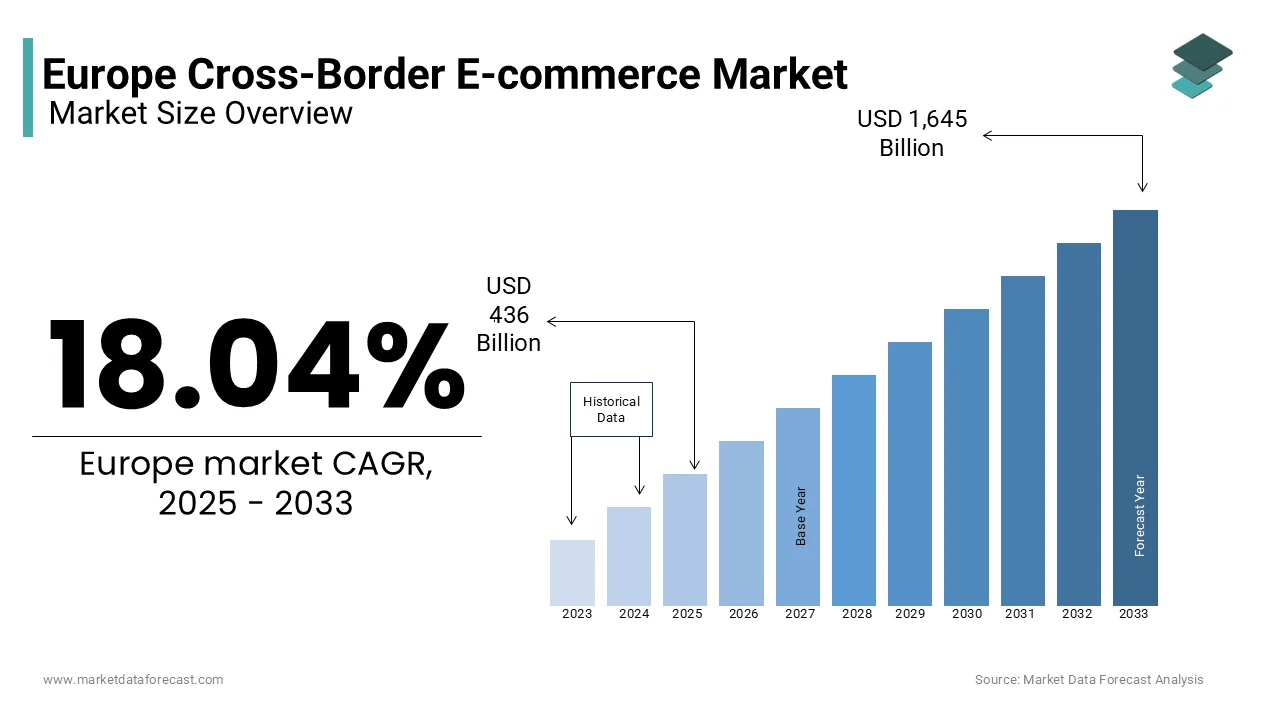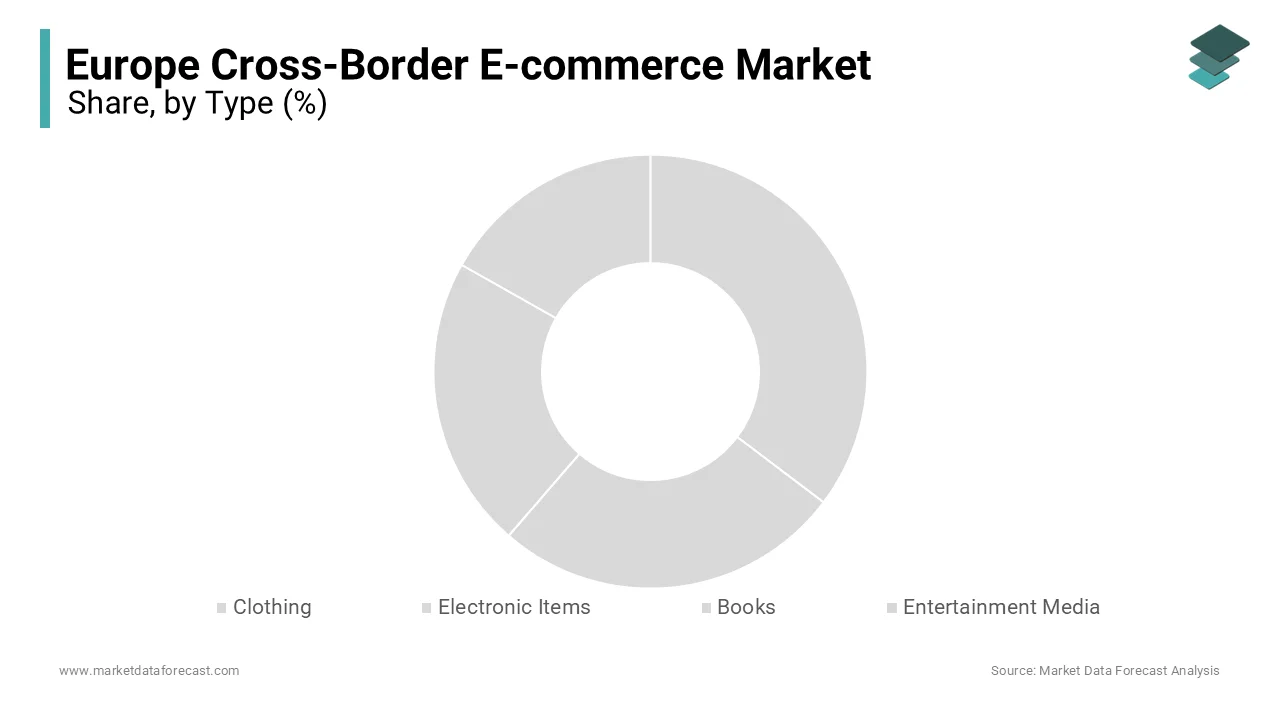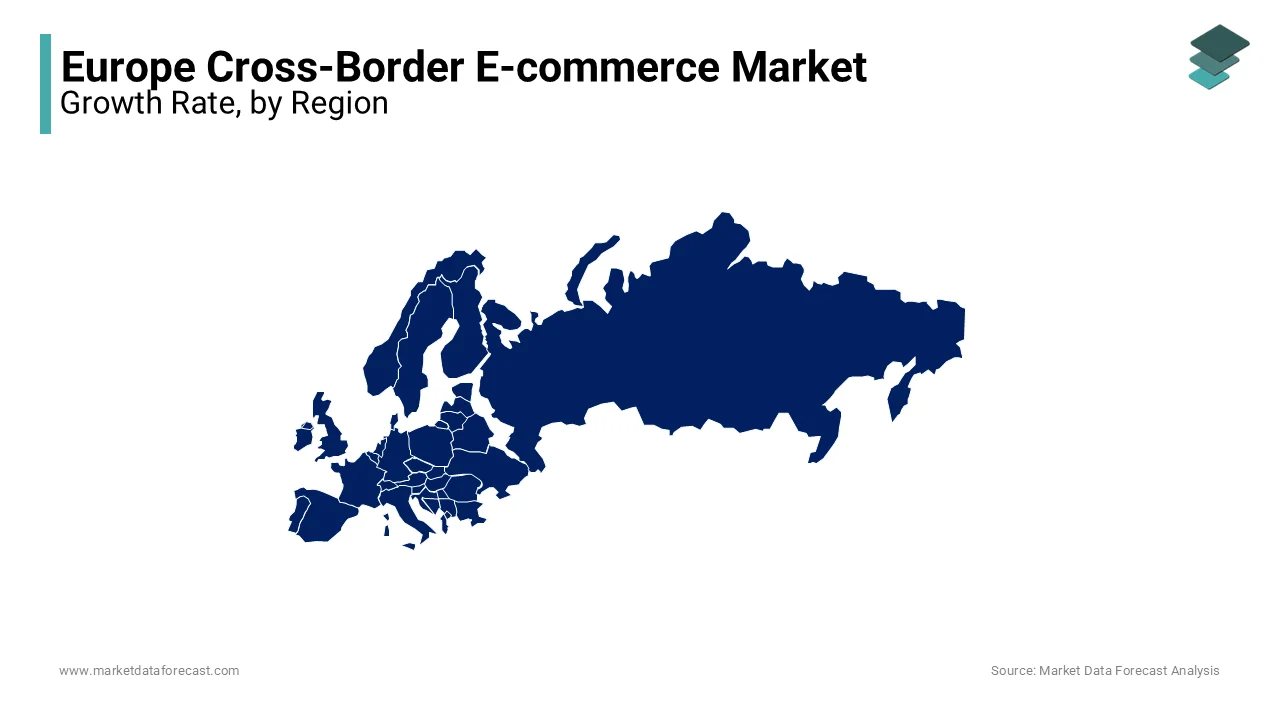Europe Cross-Border E-commerce Market Size, Share, Trends, & Growth Forecast Report Segmented By Type (Clothing, Electronic Items, Books, Entertainment Media, and Others), End-User (Teenagers/Millennials, Adults, Senior Citizens, and Others), Country (UK, France, Spain, Germany, Italy, Russia, Sweden, Denmark, Switzerland, Netherlands, Turkey, Czech Republic & Rest of Europe), Industry Analysis From 2024 to 2033
Europe Cross-Border E-commerce Market Size
The Europe cross-border e-commerce market was worth USD 369.96 billion in 2024. The European market is estimated to reach USD 1,645.45 billion by 2033, from USD 436.70 billion in 2025, rising at a CAGR of 18.04% from 2025 to 2033.

The globalization, digitalization, and consumer demand for diverse products are boosting the e-commerce ecosystem in Europe and driving the growth of the cross-border e-commerce market in Europe. Cross-border e-commerce refers to online transactions where buyers and sellers are in different countries and enable consumers to access goods and services beyond their national borders. According to Eurostat, cross-border e-commerce accounts for approximately 20% of all e-commerce transactions in Europe. As per the European Commission, over 60% of European consumers have purchased goods from international retailers, which is indicating the growing acceptance of cross-border shopping. The rise of mobile commerce, advancements in logistics, and the integration of digital payment systems in Europe are anticipated to continue to fuel the cross-border e-commerce market growth in European over the forecast period. However, challenges such as customs regulations, currency fluctuations, and delivery delays persist. As Europe transitions toward seamless digital trade, cross-border e-commerce is poised to play a pivotal role in shaping the future of retail.
MARKET DRIVERS
Growing Usage Of Digital Wallets And Secure Payment Methods
The increasing adoption of digital wallets and secure payment methods is a major driver of the Europe cross-border e-commerce market. According to Eurostat, over 70% of cross-border transactions in Europe are facilitated by digital wallets, credit/debit cards, and other secure payment platforms, ensuring trust and convenience for consumers. As per the European Central Bank, the rise of fintech innovations, such as real-time currency conversion and fraud detection systems, has significantly reduced payment barriers. Additionally, the European Investment Bank notes that the integration of blockchain technology in payment systems has enhanced transparency and security, encouraging more consumers to shop internationally. These advancements not only improve user experience but also expand the reach of retailers, making cross-border e-commerce a cornerstone of global trade.
Rising Preference From Consumers For Unique And Affordable Products
Another key driver is the growing consumer preference for unique and affordable products available only through international retailers. As per the reports of the European Consumer Organisation (BEUC), over 65% of European consumers engage in cross-border shopping to access exclusive items, luxury goods, and competitive pricing unavailable in their domestic markets. This trend is particularly pronounced among millennials and Generation Z, who prioritize variety and value. As per the European Commission, industries like fashion and electronics dominate cross-border sales, accounting for nearly 40% of total transactions. The rise of social media influencers and global marketing campaigns has further fueled this demand, creating a robust ecosystem for cross-border trade. This consumer-driven shift underscores the importance of cross-border e-commerce in meeting evolving shopping preferences.
MARKET RESTRAINTS
One significant restraint is the complexity of customs regulations and import duties, which create barriers for both consumers and retailers. According to the reports of the European Union Agency for Customs and Taxation, over 40% of cross-border transactions face delays due to varying customs policies across member states, leading to increased costs and customer dissatisfaction. Non-EU countries, such as Switzerland and Turkey, impose additional tariffs and documentation requirements, further complicating international trade. As per the European Commission, small and medium-sized enterprises (SMEs) are disproportionately affected, as they often lack the resources to navigate these complexities. Additionally, discrepancies in VAT rates across regions create uncertainty for consumers, deterring them from engaging in cross-border purchases. These regulatory challenges hinder market growth and limit accessibility for smaller players.
Issue Of Delivery Inefficiencies And High Shipping Costs
Another restraint is the issue of delivery inefficiencies and high shipping costs, which undermine the appeal of cross-border e-commerce. According to Eurostat, over 50% of European consumers cite slow delivery times and elevated shipping fees as primary deterrents to international online shopping. The European Logistics Association highlights that last-mile delivery remains a significant challenge, particularly in rural areas, where infrastructure is less developed. Furthermore, the lack of standardized return policies across borders exacerbates consumer hesitancy, with over 30% of shoppers abandoning purchases due to unclear return procedures. These logistical barriers not only increase operational costs for retailers but also reduce customer satisfaction, slowing the pace of market expansion.
MARKET OPPORTUNITIES
Technological Advancements in E-commerce
The integration of artificial intelligence (AI) and data analytics presents a significant opportunity for the Europe cross-border e-commerce market. As per the reports of the European Investment Bank, AI-driven solutions are projected to grow significantly over the forecast period and enable retailers to enhance personalization, optimize supply chains, and predict consumer behaviour. These technologies allow businesses to analyse purchasing patterns, recommend tailored products, and streamline inventory management, improving overall efficiency. As per the European Commission, industries like fashion and electronics are leveraging AI to offer localized content and pricing strategies, boosting cross-border sales. Additionally, predictive analytics helps reduce cart abandonment rates by identifying potential barriers in the purchasing process. This technological advancement positions AI as a transformative force, offering innovative solutions to meet consumer demands.
Expansion Of Cross-Border E-Commerce Throughout Europe
Another promising opportunity lies in the expansion of cross-border e-commerce into emerging markets within Europe. According to Eurostat, Eastern European countries, such as Poland and Romania, are experiencing rapid internet penetration and rising disposable incomes, creating a fertile ground for international retailers. As per the European Small Business Alliance, over 50% of SMEs in these regions are adopting e-commerce platforms to reach global audiences. Furthermore, initiatives like the EU Digital Single Market aim to harmonize regulations and reduce trade barriers, fostering seamless cross-border transactions. By tapping into these underserved markets, retailers can unlock new revenue streams and drive inclusivity, positioning cross-border e-commerce as a catalyst for economic growth.
MARKET CHALLENGES
Concern Over Cybersecurity Threats And Data Privacy Risks
One major challenge is the growing concern over cybersecurity threats and data privacy risks associated with cross-border transactions. As per the reports of the European Union Agency for Cybersecurity (ENISA), 40% increase in cyberattacks targeting e-commerce platforms over the past two years, with attackers exploiting vulnerabilities to steal sensitive consumer data. Non-compliance with GDPR can result in fines of up to EUR 20 million or 4% of global annual turnover, as stated by the European Commission. Organizations face significant pressure to ensure robust data protection measures, which often require additional investments in cybersecurity infrastructure. Furthermore, Eurostat highlights that over 60% of consumers hesitate to engage in cross-border shopping due to fears of identity theft and fraudulent activities. These challenges not only increase operational risks but also undermine consumer trust, slowing the regional market growth.
Lack Of Standardized Regulations
Another significant challenge is the lack of standardized regulations and legal frameworks governing cross-border e-commerce. The European Commission notes that discrepancies in consumer protection laws, tax policies, and dispute resolution mechanisms across member states create confusion for both buyers and sellers. For instance, non-EU countries impose varying import duties and restrictions, complicating international trade. According to the European Investment Bank, over 50% of SMEs struggle to comply with these fragmented regulations, limiting their ability to scale operations. Additionally, the absence of unified standards for product safety and labeling exacerbates compliance challenges. These inconsistencies not only hinder market expansion but also create barriers for smaller players seeking to compete on a global scale.
REPORT COVER
|
REPORT METRIC |
DETAILS |
|
Market Size Available |
2024 to 2033 |
|
Base Year |
2024 |
|
Forecast Period |
2025 to 2033 |
|
CAGR |
18.04% |
|
Segments Covered |
By Type, End-User, and Country |
|
Various Analyses Covered |
Regional & Country Level Analysis, Segment-Level Analysis, DROC, PESTLE Analysis, Porter’s Five Forces Analysis, Competitive Landscape, Analyst Overview on Investment Opportunities |
|
Countries Covered |
UK, France, Spain, Germany, Italy, Russia, Sweden, Denmark, Switzerland, Netherlands, Turkey, Czech Republic, and Rest of Europe |
|
Market Leaders Profiled |
LALAMI, eBay, Alibaba, Lightinthebox, Haitao, Huarun Tesco, Rakuten global market, Wzhouhui, 3weiduand, and AliExpress. |
SEGMENTAL ANALYSIS
By Type Insights
The electronics segment held the leading share of 40.3% in the European market in 2024. The growth of the electronics segment is driven by the high demand for affordable and innovative gadgets, such as smartphones, laptops, and smart home devices that are often sourced internationally. As per the European Commission, over 60% of electronic purchases in Europe are cross-border transaction due to the competitive pricing and exclusive product availability. The importance of electronics items lies in catering to tech-savvy consumers and supporting the growth of global brands, which is contributing to the expansion of the electronics segment in the European market.

The clothing segment is predicted to register the fastest CAGR of 18.4% over the forecast period. Factors such as the increasing popularity of fast fashion and luxury apparel available through international retailers are propelling the expansion of the clothing segment in the European market. According to Eurostat, over 50% of millennials and Generation Z consumers purchase clothing from cross-border platforms owing to the trends promoted on social media.
By End-User Insights
The teenagers and millennials segment dominated the market by accounting for 55.8% of the European market share in 2024. The domination of teenagers and millennials segment is primarily attributed to their tech-savviness, preference for unique products, and willingness to shop internationally. According to the Eurostat, over 70% of this demographic engages in cross-border shopping due to the social media influencers and global marketing campaigns.
The adults segment is anticipated to expand at a CAGR of 15.9% over the forecast period. The rising adoption of digital tools and platforms among older consumers that are now prioritizing convenience and variety in their shopping experiences is propelling the expansion of the adults segment in the European market. As per the reports of the European Commission, over 40% of adults aged 35-54 are engaging in cross-border e-commerce owing to the availability of premium and niche products.
REGIONAL ANALYSIS
Germany held 26.8% of the European cross-border e-commerce market in 2024. The domination of Germany is majorly driven by its strong manufacturing base, high internet penetration, and consumer demand for international products. According to the European Investment Bank, strategic position of Germany as a logistics hub enables seamless cross-border trade. Additionally, initiatives like the EU Digital Single Market have accelerated adoption, is further contributing to the German market growth.

The UK is anticipated to showcase the promising CAGR in the European market over the forecast period owing to the robust e-commerce infrastructure of the UK, advanced payment systems, and consumer preference for global brands. According to the British Retail Consortium, over 65% of UK consumers engage in cross-border shopping due to the competitive pricing and exclusive product availability. London’s status as a financial hub has also spurred demand for luxury goods and electronics.
France is another key market for cross-border e-commerce in the European region and is estimated to hold a substantial share of the European market over the forecast period. The focus of France on digital transformation and consumer protection has significantly boosted cross-border e-commerce adoption. According to the reports of the European Commission, France’s investment in secure payment systems and logistics infrastructure has created a strong demand for international retail platforms. Additionally, its large millennial population drives demand for trendy and affordable products, positioning France as a key contributor to the market.
KEY MARKET PLAYERS
The major players in the cross-border e-commerce market include LALAMI, eBay, Alibaba, Lightinthebox, Haitao, Huarun Tesco, Rakuten global market, Wzhouhui, 3weiduand, and AliExpress.
MARKET SEGMENTATION
This research report on the Europe cross-border e-commerce market is segmented and sub-segmented into the following categories.
By Type
- Clothing
- Electronic Items
- Books
- Entertainment Media
- Others
By End-User
- Teenagers/Millennials
- Adults
- Senior Citizens
- Others
By Country
- UK
- France
- Spain
- Germany
- Italy
- Russia
- Sweden
- Denmark
- Switzerland
- Netherlands
- Turkey
- Czech Republic
- Rest of Europe
Frequently Asked Questions
What is driving the growth of cross-border e-commerce in Europe?
The growth is driven by increased internet penetration, improved logistics networks, and consumer demand for international brands and better pricing.
Which product categories are most popular in European cross-border e-commerce?
Fashion, electronics, beauty products, and home goods are among the top-selling categories in the region.
What is the impact of Brexit on cross-border e-commerce between the UK and the EU?
Brexit has led to increased customs paperwork, higher import duties, and longer delivery times for businesses selling between the UK and the EU.
What strategies can businesses use to succeed in the European cross-border e-commerce market?
Businesses should optimize localized websites, offer multiple payment methods, ensure compliance with EU regulations, and partner with reliable logistics providers.
Related Reports
Access the study in MULTIPLE FORMATS
Purchase options starting from $ 2000
Didn’t find what you’re looking for?
TALK TO OUR ANALYST TEAM
Need something within your budget?
NO WORRIES! WE GOT YOU COVERED!
Call us on: +1 888 702 9696 (U.S Toll Free)
Write to us: [email protected]